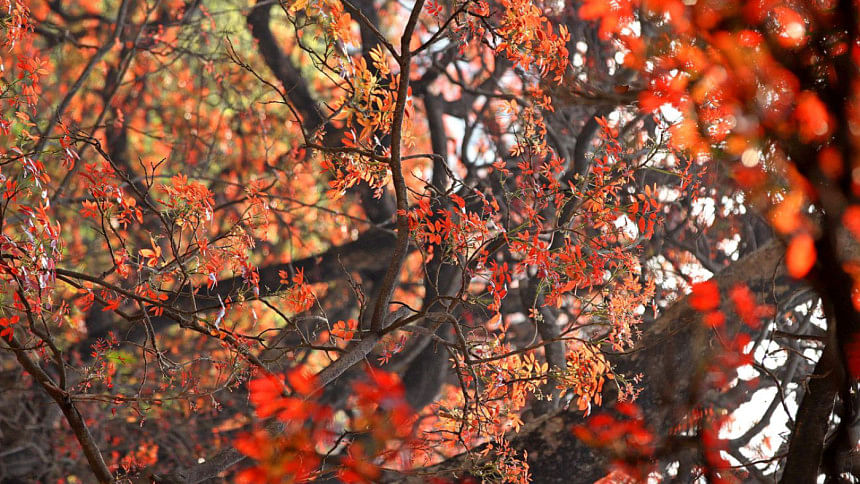Salad, balmy days of Dhaka

WHAT we miss is what we value; and what we value is what we long for. The yearning for the old charms of Dhaka, momentarily ignited through the red-splashed foliage of the Kusum tree (Ceylon oak) in Ramna Garden pictured in this article, is no ordinary nostalgia.
IT is being celebrative and aesthetic about the salad days gone by, of pristine beauty and romantic association.
Dhaka is said to have derived its name from a tree called 'Dhak' named in the same breath with Shimul and Polash. Rabindranath Tagore likened Polash, the bright orange flower, to fire.
As you go along the Crescent Lake you see an avenue lined with Krishnachura trees with their orange-red flowers and foliages delighting your eyes. The month of Falgun heralding the spring literally comes to bloom with a mélange of colourful trees and clusters of flowers that you gaze much to your optical relief.
In the '60's and '70's we could walk from Salimullah Muslim Hall through Dhaka Medical College to old Dhaka University Arts Building in sweltering summer shaded by the branches of long rain trees and conifers. Then you could go to Fuller Road and take the left-hand bend to Curzon Hall and Ramna Garden with ease and comfort.
The whole range of academic buildings, engineering, arts and science and the residential halls were cooled as though through the soothing tapestry of abounding greenery.
Ramna Uddyan, the premier breathing space of the city has recorded a total of 126 wild plant species belonging to 51 genres and 277 ornamental and fruit-bearing trees of 78 genres (source: Shyamoly Ramna by Sourav Mahmud).
Botanical Garden in Mirpur, another major tree-clad area, has 1,010 species of herbal, decorative, shade-giving and fruit-bearing trees.
Yet, twenty years of satellite data recently revealed that 66.87 square kilometre vegetation coverage of Dhaka metropolitan area has been lost over the period (source: Dept of Geography and Environment, Faculty of Earth and Environmental Sciences, DU). At this rate, the vegetation is depleting at about four square kilometre per year.
Like in the population control drive we aim at bringing down net reproductive rate which is pivotal to checking the baby boom so also in maintaining the right proportion of vegetation we have to work out net replenishment rate and work to achieve it. Keeping down population and raising vegetation levels are self-evidently correlated priorities.
Dhaka's tree cover is not even half the national average of 6% to 8%. Ideally, in both cases it should have been 25% of the land area. Practically, at least 12% is the bare minimum.
Singapore, a city ranking second in terms of population density in the world has shrubbery corners like oases of private space in areas experiencing maximum footfalls. Small advertisements could be placed on to the sides of shrubbery -- small is beautiful as well as well-publicising from the customer's point of view. Kolkata too has enchanting, well-manicured bushy corners.
Dhaka, once known as the Venice of the East, is sadly disserved by receding, dying and stinking rivers. Balu, Shitalakhya and Buriganga that formed the lifeline of the city are murky shadows of their former selves. Note that the river-lined city was also endowed with a network of natural channels and wetlands in and around it. These too have been pushed into extinction or grabbed to raise buildings on. Thus the luxuriant vegetation and the cheerful environment which once showcased the charms of this historic city are all but lost.
Famous litterateur Buddha Dev Basu, who used to live in Purana Paltan and study in Dhaka University in 1927, called Dhaka the Garden City. The city of gardens is now a vast closed space of a concrete jungle with its mangled sets of teeth jutting out or piercing up. Add to the brick and mortar, the metal and steel clanking on a new construction site or the distended billboards overhead that block the skyline. You neither can see the blue sky nor the tucked away trees in the parks, so walled up the city has become.
Indeed, we have no dearth of complaints about Dhaka, and many for right reasons. As if to match it, The Economist intelligence unit has ranked Dhaka as the second most unlivable city in the world.
Other cities, including some very iconic ones, have had their share of scorn and harsh expletives. Of London, poet P. B. Shelly said: "Hell is much like London, a populous and a smoky city." British Prime Minister Gladstone had to press his handkerchief to his nose in the House of Common's library to ward off the stink of the adjoining Thames. Then with a resolute will he got the cesspool of a river reclaimed on a double-quick basis, providing examples to draw on to enliven moribund rivers.
You have John Gunther's graphic description of Addis Ababa "looking as if it has been dragged piecemeal from an aeroplane carrying rubbish."
Let no one for the lack of timely intervention in Dhaka and reinvention of the city borrow the heartbreaking words of Frank Lloyd Wright to describe Dhaka's predicament some day. The American architect had said: "The only way to improve Pittsburgh would be to abandon it."
The writer is Associate Editor, The Daily Star.
E-mail: [email protected]

 For all latest news, follow The Daily Star's Google News channel.
For all latest news, follow The Daily Star's Google News channel. 



Comments